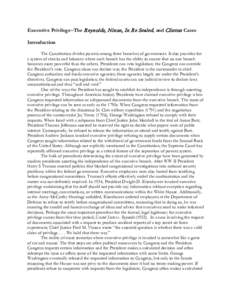 Date: 2014-10-27 15:54:35United States government secrecy Presidency of the United States United States v. Reynolds Executive privilege Warren E. Burger President of the United States Supreme Court of the United States Fred M. Vinson United States v. Nixon Law Government Politics of the United States | |  Executive Privilege–The Reynolds, Nixon, In Re Sealed , and Clinton Cases Introduction The Constitution divides powers among three branches of government. It also provides for a system of checks and balances where each Executive Privilege–The Reynolds, Nixon, In Re Sealed , and Clinton Cases Introduction The Constitution divides powers among three branches of government. It also provides for a system of checks and balances where each
Add to Reading ListSource URL: csac.history.wisc.eduDownload Document from Source Website File Size: 139,92 KBShare Document on Facebook
|

![[removed]SJR123 Portrait and Bust of Former Chief Justice Earl Warren [removed]SJR123 Portrait and Bust of Former Chief Justice Earl Warren](https://www.pdfsearch.io/img/853585c38a880c193b03b5ddb5725b44.jpg)
![71 S T A T . ] PUBLIC LAW[removed]APR. 23, 1957 U5r 71 S T A T . ] PUBLIC LAW[removed]APR. 23, 1957 U5r](https://www.pdfsearch.io/img/0e2eba18e2a73551e5390157a0536baa.jpg)
![71 S T A T . ] PUBLIC LAW[removed]APR. 23, 1957 U5r 71 S T A T . ] PUBLIC LAW[removed]APR. 23, 1957 U5r](https://www.pdfsearch.io/img/bb1e177116cae51b8f25b3360951f4a4.jpg)
![Microsoft Word[removed]Inauguration Microsoft Word[removed]Inauguration](https://www.pdfsearch.io/img/a0fade51d6ad3e3add290583bd85abfd.jpg)

 Executive Privilege–The Reynolds, Nixon, In Re Sealed , and Clinton Cases Introduction The Constitution divides powers among three branches of government. It also provides for a system of checks and balances where each
Executive Privilege–The Reynolds, Nixon, In Re Sealed , and Clinton Cases Introduction The Constitution divides powers among three branches of government. It also provides for a system of checks and balances where each